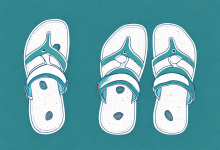Are you in the market for a new pair of sandals with straps? Finding the perfectly fitted strapped sandal can be a complicated and time-consuming process, but we are here to make it easier. For a comfortable fit and ideal style, use this guide as a step-by-step resource to help you determine the right size sandal with straps for your needs.
Identifying the Right Size Sandal for Your Foot
Purchasing the right size sandal should be your priority when shopping. A sandal that is too small or too big can lead to foot fatigue, chafing, and other irritation. The best way to get an accurate fit for your feet is to measure both your foot length and width and compare them to the size chart of the sandal brand you are interested in. Pay special attention to the width measurement; sandals that are too narrow can put pressure on the sides of your feet, while sandals that are too wide can cause slipping and sliding, which can lead to blisters.
Comparing Different Types of Sandals with Straps
Sandals with straps come in a variety of shapes, sizes, and designs. Common strap types include ankle straps, mid-foot straps, toe straps, and slingback straps. Be sure to note the differences between these types of straps, as they all offer different levels of support and stability. Furthermore, it is important to consider the weight of a sandal when determining the right size; heavier sandals may require a bigger size, while lighter sandals may call for a smaller size.
Measuring Your Foot for the Perfect Fit
Before you start shopping for strapped sandals, measuring your foot is essential for finding the perfect fit. Start by tracing an outline of your foot (without wearing any socks) onto a piece of paper and use a ruler to measure the length and width of your foot from the tracing. Once you have determined your foot length and width, it is important to compare these measurements to the size chart of the sandal brand you are interested in. Keep in mind that sandals with an adjustable strap design offer more room for adjustment if needed.
Knowing What to Look for in a Quality Sandal
Choosing a quality strapped sandal requires paying attention to key features such as materials, stitching, and cushioning. Make sure there are no gaps or missing stitches; they can cause friction that lead to discomfort or even injury. The materials should be lightweight and breathable and should provide ample cushioning and arch support. As an added bonus, straps made with materials such as leather or suede offer durability and added comfort.
Tips for Finding Comfortable Strapped Sandals
When trying on strapped sandals, always try them on with socks that are similar to what you would usually wear. Walk around in them in store to make sure they fit properly before buying. When you get home, spend more time walking around to further assess the fit. If you find any areas that cause discomfort or pinching, bring the sandals back for an exchange or return.
Picking Out the Ideal Style of Strap Sandal for You
Besides comfort, finding the right style of sandal is also important. When shopping for stylish sandals with straps, make sure to look for colors and patterns that match your wardrobe. Also look for supportive details like extra heel padding or light arch support if you want extra stability.
Finding Well-Fitting Strapped Sandals on a Budget
If you’re shopping on a budget, don’t risk buying ill-fitting sandals. For quality options that won’t break the bank, consider browsing online sales and discount websites for styles that fit your needs. Even if you have to spend a little bit more than planned, investing in well-fitting strapped sandals is worth it in the long run.
Long-Term Care and Maintenance for Strapped Sandals
Make sure to perform regular maintenance on your strapped sandals in order to keep them in the best possible condition over time. Clean the straps of dirt and salt deposits after every use with a small brush and warm water. You can also apply waterproofing spray or cream to help waterproof the materials. Additionally, opt for a box or shoe bag when storing them instead of leaving them lying around as this can reduce wear and tear.
Troubleshooting Common Fitting Problems with Strap Sandals
If you are having trouble finding a well-fitted strapped sandal, there are some troubleshooting methods that may help. For instance, adding an insert or orthotic could provide extra cushioning and support if the sandal does not offer enough. You can also try wearing a thicker sock or using toe grips for slipping issues caused by loose straps or sandals being too big. Lastly, adding an adjustable strap extender to loosen the strap slightly could be a helpful fix.
Now that you know how to choose the right size for sandals with straps, try out our tips for success. Whether you are looking for comfort, style, or affordability, correctly fitted straps will offer all three in one go! Now go enjoy those summer strolls!



